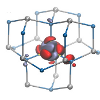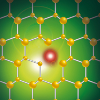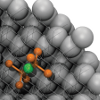Template:Highlights
Together with colleagues in the United States, we have investigated and proposed a new kind of material for photovoltaics. In strongly correlated insulators, strong Coulomb interactions make highly photoexcited electron-hole pairs decay fast into multiple electron-hole pairs via impact ionization, thus preventing slower energy dissipation to heat by phonons. The prototypical M1-type vanadium-oxide insulator have been used for computational simulations, which may be a first example of a new class of photovoltaic materials.
Phys. Rev. B 90, 165142 (2014). DOI:10.1103/PhysRevB.90.165142
In collaboration with Bremen Center for Computational Materials Science we have identified such a diamond surface that would be ideal to host shallow implanted nitrogen-vacancy centers in diamond for sensing at the nanoscale.
Nano Letters 14 4772-4777 (2014). DOI:10.1021/nl501927y
In the field of methodology development, we have constructed a DFT scheme combining hybrid exchange and DFT+U strategies. This machinery seems to be an efficient tool in DFT calculations involving solid-state defects with highly localized electronic orbitals, as its tests on two typical systems show.
Physical Review B 90 035146 (2014) DOI:10.1103/PhysRevB.90.035146
Our group members at Wigner ADMIL laboratory has succeeded manufacturing carbon antisite–vacancy colour centres in silcon carbide nanoparticles. These colour centres behave as single-photon emitters, and therefore may be used in the future in nanometrology and quantum informatics. The biocompatibiliy of SiC makes these defects ideal candidates for biosensing at the molecular level.
ACS Nano 8 7938-7947 (2014). DOI:10.1021/nn502719y
In an international cooperation with Japanese and Australian colleagues, we supported the establishment and identification of the carbon antisite–vacancy pair as a new kind of single-photon emitter in silicon carbide with theoretical work and computational simulation. The results have been highlighted in Nature Physics and Nature Photonics.
Nature Materials 13 151-156 (2014) DOI:10.1038/nmat3806
In a cooperation with partners in Russia and Germany, we have taken part in the work of predicting and validating the properties of silicon-vacancy colour centres in nanosized diamond particles. We have contributed with time-dependent DFT calculations, not carried out on such large systems so far. Nanoparticles for validating experiments have been extracted from a meteorite sample, but production of similar artificial nanoparticles seems to be very prospective in e.g. biosensing.
Nature Nanotechnology 9, 54–58 (2014) DOI:10.1038/NNANO.2013.255





